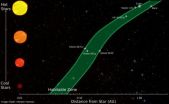(Press-News.org) UNIVERSITY PARK, Pa. -- Researchers searching the galaxy for planets that could pass the litmus test of sustaining water-based life must find whether those planets fall in a habitable zone, where they could be capable of having liquid water and sustaining life. New work, led by a team of Penn State researchers, will help scientists in that search.
Using the latest data, the Penn State Department of Geosciences team has developed an updated model for determining whether discovered planets fall within a habitable zone. The work builds on a prior model by James Kasting, Evan Pugh Professor of Geosciences at Penn State, to offer a more precise calculation of where habitable zones around a star can be found.
Comparing the new estimates with the previous model, the team found that habitable zones are actually farther away from the stars than previously thought.
"This has implications for finding other planets with life on them," said post-doctoral researcher Ravi kumar Kopparapu, a lead investigator on the study, which will be published described in Astrophysical Journal.
For the paper, Kopparapu and graduate student Ramses Ramirez used updated absorption databases of greenhouse gases (HITRAN and HITEMP). The databases have more accurate information on water and carbon dioxide than previously was available and allowed the research team to build new estimates from the groundbreaking model Kasting created 20 years ago for other stars.
Using that data and super computers at Penn State and the University of Washington, the team was able to calculate habitable zones around other stars. In the previous model, water and carbon dioxide were not being absorbed as strongly, so the planets had to be closer to the star to be in the habitable zone.
The new model has already found that some extrasolar planets previously believed to be in habitable zones may, in fact, not be.
The new model could also help scientists with research that is already under way. For example, the model could be used to see if planets the NASA Kepler mission discovers are within a habitable zone. The Kepler mission has found more than 2,000 potential systems that could be investigated.
The data could assist with a Habitable Zone Planet Finder a team of scientists in Penn State's Department of Astronomy and Astrophysics is building. In 2011, that team received a National Science Foundation grant to develop an instrument to find planets in habitable zones. The precision spectrograph, which is under construction, will help scientists find Earth-sized planets in the Milky Way that could sustain liquid water.
In the future, the model could also be useful for research done with Terrestrial Planet Finder telescopes, which would guide users of the supersized telescopes on where to look.
While in the new model Earth appears to be situated at the very edge of the habitable zone, the model doesn't take into account feedback from clouds, which reflect radiation away from the earth and stabilize the climate.
INFORMATION:
In addition to Kopparapu, Ramirez and Kasting, researchers on the project are: Vincent Eymet, Laboratoire d'Astrophysique de Bordeaux at the Universite de Bordeaux; Tyler D. Robinson and Victoria Meadows, University of Washington; Suvrath Mahadevan, Ryan C. Terrien and Rohit Deshpande, Penn State; and Shawn Domagal-Goldman, NASA Goddard Space Flight Center.
Support for the research comes from NASA Astrobiology Institute's Virtual Planetary Laboratory. An interactive calculator to estimate Habitable Zones is online: depts.washington.edu/naivpl/content/hz-calculator.
The paper is available online at: http://arxiv.org/abs/1301.6674
Researchers develop model for identifying habitable zones around star
2013-01-30
ELSE PRESS RELEASES FROM THIS DATE:
Reconcilable differences: Study uncovers the common ground of scientific opposites
2013-01-30
Searching for common elements in seemingly incompatible scientific theories may lead to the discovery of new ones that revolutionize our understanding of the world.
Such is the idea behind a mathematical framework Princeton University researchers developed that strips away the differences between scientific laws and theories to reveal how the ideas are compatible. In a recent report in the journal Physical Review Letters, the authors explain how the mathematical model finds common ground between the famously at-odds physics equations that govern classical and quantum ...
Mindfulness meditation heightens a listener's musical engagement
2013-01-30
EUGENE, Ore. -- (Jan. 30, 2013) -- When De'Anthony Thomas returned the opening kickoff for a touchdown in the 2013 Fiesta Bowl, says University of Oregon researcher Frank Diaz, Thomas put Ducks fans into a heightened zone of engagement for watching the game, not unlike what was experienced by music students who were first exposed to a brief session of mindfulness meditation before hearing an opera passage.
As a high school orchestra and band educator in Florida, Diaz had flirted with yoga and light meditation in a quest to heighten music engagement. He noticed, anecdotally, ...
Chronic kidney disease increases risk of death for both women and men
2013-01-30
A new study from the Johns Hopkins Bloomberg School of Public Health and the Chronic Kidney Disease Prognosis Consortium (CKD-PC) found that in general chronic kidney disease is similarly associated with a higher risk of death and end stage renal disease for both women and men. The findings were released online in advance of publication in BMJ.
Chronic kidney disease affects 10 to 16 percent of adults worldwide. Current thresholds for chronic kidney disease are based on two kidney measures, estimated glomerular filtration rate (GFR) and albuminuria, a measure of protein ...
Researchers help confirm value of flow-diverting device for most challenging aneurysms
2013-01-30
CINCINNATI—A multi-center study supports the effectiveness of the newest technology available for the treatment of difficult, life-threatening brain aneurysms. The technology, the Pipeline embolization device, is a flow diverter that redirects blood flow away from wide-necked or giant aneurysms that cannot be treated in more conventional ways.
Andrew Ringer, MD, director of the division of cerebrovascular surgery and professor of neurosurgery and radiology at the University of Cincinnati (UC) College of Medicine, led the Cincinnati portion of the study, which was published ...
Scientists uncover previously unknown mechanism of memory formation
2013-01-30
JUPITER, FL, January 30, 2013 – It takes a lot to make a memory. New proteins have to be synthesized, neuron structures altered. While some of these memory-building mechanisms are known, many are not. Some recent studies have indicated that a unique group of molecules called microRNAs, known to control production of proteins in cells, may play a far more important role in memory formation than previously thought.
Now, a new study by scientists on the Florida campus of The Scripps Research Institute has for the first time confirmed a critical role for microRNAs in the ...
Study: Alternate walking and running to save energy, maintain endurance
2013-01-30
COLUMBUS, Ohio—Forget "slow and steady wins the race." A new study shows that, at least sometimes, the best way to conserve energy and reach your destination on time is to alternate between walking and running—whether your goal is the bus stop or a marathon finish line.
In the January 30, 2013 issue of the Journal of the Royal Society Interface, researchers examined how people budget their time as they travel on foot to reach a destination at a particular appointed time. The study found that when people have neither too much time nor too little time to reach their destination, ...
In-brain monitoring shows memory network
2013-01-30
Working with patients with electrodes implanted in their brains, researchers at the University of California, Davis, and The University of Texas Health Science Center at Houston (UTHealth) have shown for the first time that areas of the brain work together at the same time to recall memories. The unique approach promises new insights into how we remember details of time and place.
"Previous work has focused on one region of the brain at a time," said Arne Ekstrom, assistant professor at the UC Davis Center for Neuroscience. "Our results show that memory recall involves ...
New study shows 'just a bite' will satisfy
2013-01-30
How much chocolate would you need to eat to be satisfied? Less than half as much as you think, according to this recently published Cornell University snacking study. Using chocolate chips, apple pie, and potato chips, researchers Ellen van Kleef, Mitsuru Shimizu, and Brian Wansink designed a study to determine if people who were given smaller portions of snack foods would feel hungrier or satisfied fifteen minutes after eating.
Two groups with different portion sizes were tested. The larger portion size group was given 100g of chocolate, 200g of apple pie, and 80g ...
Cornell engineers solve a biological mystery and boost artificial intelligence
2013-01-30
ITHACA, N.Y. – By simulating 25,000 generations of evolution within computers, Cornell University engineering and robotics researchers have discovered why biological networks tend to be organized as modules – a finding that will lead to a deeper understanding of the evolution of complexity. (Proceedings of the Royal Society, Jan. 30, 2013.)
The new insight also will help evolve artificial intelligence, so robot brains can acquire the grace and cunning of animals.
From brains to gene regulatory networks, many biological entities are organized into modules – dense clusters ...
Going trayless study shows student impact
2013-01-30
If you need any evidence of the impact of student research on life at American University's campus, look no further than something that's missing.
Trays.
Following a 2009 study at American University's main dining hall that showed a significant reduction in food waste and dishes used when trays were removed, trays have mostly gone the way of beanies and sock hops.
Now, for the first time, a new paper coauthored by AU professor Kiho Kim and AU environmental studies graduate Stevia Morawski, provides hard evidence of big energy savings as well as a 32 percent reduction ...




